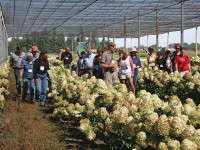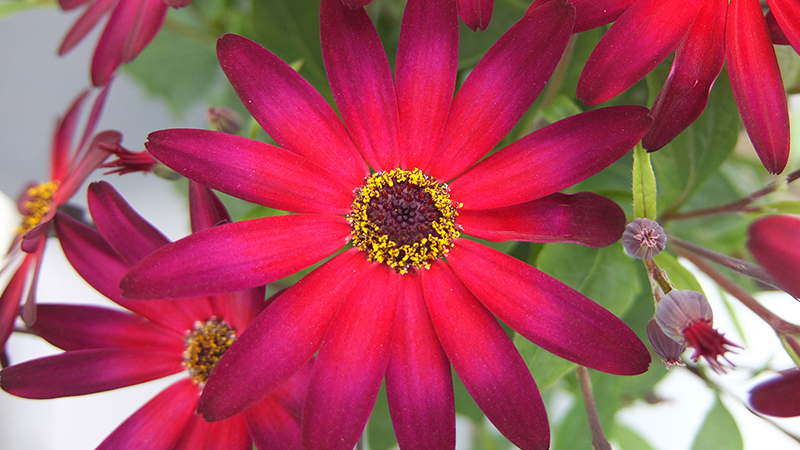The Little Engine That Could

There has been a good deal of turmoil on Wall Street recently. It seems every time you turn around, one company after another is failing. Whether because of greed, incompetence or just bad luck, giants like Lehman Brothers, AIG, Fannie Mae and Freddie Mac have either disappeared or are on life support.
Every industry, including horticulture, is prone to these fluctuations, and we too have seen small and large companies file for bankruptcy. This has been a tough summer and autumn. With all the negative comments swirling around us about buyers cutting back, less interest in new plants, climate change, offshore competition and shipping woes, it is hard to be upbeat.
But not FOR me. I have recently been rejuvenated and received a transfusion of enthusiasm. I just returned from one of the most upbeat groups of people I’ve ever met. And I found them in an area of horticulture that most leaders in our industry abandoned long ago: domestic cut flower production. Believe it or not.
Reason To Get Excited
These people are the same as you and me, trying to make a living competing with weather, labor issues, financial issues and market volatility. They have every right to be pessimistic and by all counts, should not be able to survive for long, let alone laugh and share ideas with anyone who asks.
Perhaps one of the reasons they are enthusiastic is that they are backed by one of the most innovative and supportive organizations I’ve come across. It is the Association of Specialty Cut Flower Growers (ASCFG), and it just completed its national conference in Portland, Ore. This would not be newsworthy except this organization–given no chance of surviving in 1988–just celebrated its 20th anniversary! Growers, industry supporters and allied trade people who attended were all focused on being successful. Companies like Gloeckner, American Takii and Chrysal, which have been supporters forever, were there along with plant people and booksellers, intermingling with growers large and small from around the country.
It is not that trade shows and smiling faces do not happen elsewhere, but these faces were truly optimistic and made up of generous people who were there to learn, teach and make the organization even stronger. I watched as old timers took aside young people and explained when to harvest a particular flower or how to treat stems with fall fruit. Tours to gorgeous farms, like Patrick Zweifel’s Oregon Coastal Flowers with callas and hydrangeas to die for or Bernadette Hammelman’s productive dried flower operation, were packed.
Speakers like Alison Kutz-Troutman touting compost tea, and Erin Benzakein and Jeriann Sabin, who together displayed the beauty and facility of old-fashioned roses, were swamped with questions after their sessions. Murray Rosen’s session on cut flower clematis was so popular he could barely leave the room when it ended.
Here To Serve The People
And talk about support for an organization and its goals: The auction that benefits the ASCFG Research Foundation brought unheard-of sums for celosia seeds ($300). An upcoming first edition of Lane Greer and John Dole’s book on woody cut flowers went for more than $600! I haven’t made that much with all my books combined, and they are in print. (Hmm, maybe there is a lesson here.) The topper of support, however, was a quilt. Handmade by several ASCFG members across the country and pieced together by a local committee member, it was quite beautiful. As lovely as it was, no retail store would have been able to match the $3,000 it brought to the foundation. Now that is support!
So why is this association still around? I expect if you ask the members, they will tell you it serves a useful purpose. Love is good, but functionality is better when it comes to trade associations. Here are comments from a few members:
“Joining the ASCFG is the single-most useful thing I did to grow great cut flowers. You save more than the membership fee each year in things learned, lessons on what not to do. One of the greatest assets of membership is the bulletin board, where you can search on all kinds of topics for growing, harvesting and marketing tips.”–Polly Hutchison, Connecticut
“Growing cut flowers is a complex and detail-oriented endeavor. Who can do it alone? No one. With the ASCFG on our side, its members’ network, regional meetings and national conference, success as growers is all but assured. Risk is minimized. Questions are answered. And we feel part of something larger, something as great as our individual and collective efforts.”–Joe Caputi, Virginia
“The reason I am a supplier member of ASCFG is because it is one of the most dynamic and unique organizations in our industry. The networking and the bulletin board forum are fantastic. Each year, we are doing more business with the members of this organization. It is a no-brainer.”–Ko Klaver, Zabo Plant
“For us newbies, starting a flower business felt like jumping out of an airplane: thrilling, exciting and scary all at once! The ASCFG has been our parachute, guiding and supporting us. It’s been an unbelievable ride and what a view! If we hadn’t joined? Let’s not even go there.”–Andrea Gagnon, Virginia
Yes, it is tough out there for everyone. Optimism doesn’t pay the bills, but enthusiasm sure helps make the job more pleasant. Surround yourself with good people, and get out and meet your colleagues–you may get carried away with enthusiasm. These people do every day.









